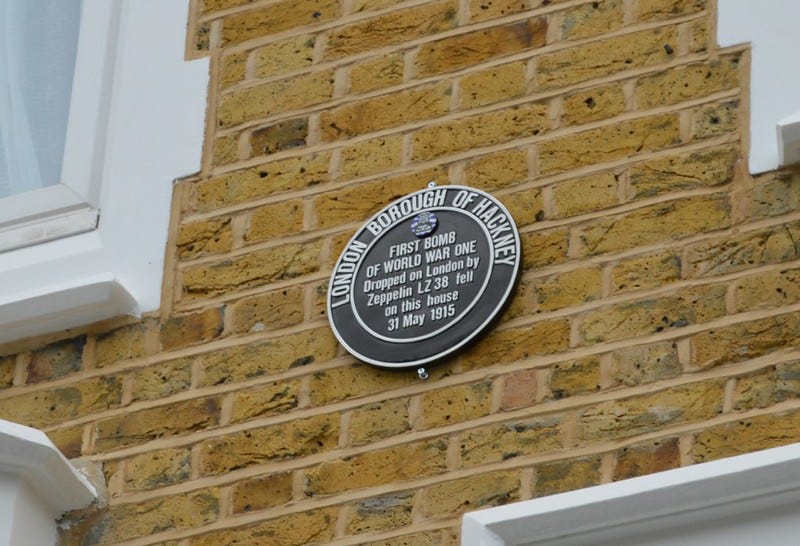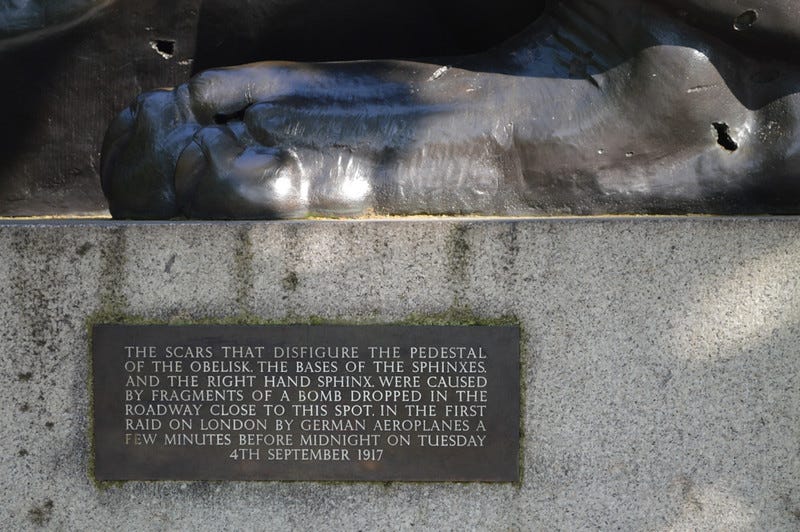Zeppelin Attack! Where To See The Scars Of the First Blitz
Bomb damage and plaques from the first world war.
Welcome to your Friday newsletter.
Before the 20th century, London had not been attacked by a foreign power for many centuries. The first world war changed all that. The advent of giant airships (Zeppelins) and the first heavy bombers (Gothas) made it possible for Germany to bring the war to British soil. Between 1915 and 1918, London was bombarded on many occasions, killing well over 1,000 people. The campaign, sometimes known as the First Blitz, has not lodged as firmly in our collective memory as the Blitz of 1940-41. Yet for the people of the time it must have been just as terrifying. For today’s article, I’ve visited some of the key sites from those first bombing raids, discovering numerous plaques and even some surviving bomb damage from the First Blitz.
That’s after the radar of upcoming London history events.
History Radar
🛬❊ CROYDON AIRPORT: This Sunday (7 April) is the monthly open day at Croydon Airport. If you’ve never had the pleasure, then I’d strongly recommend it. London’s first international airport, Croydon’s origins are in the first world war when (topical for today’s main article) it was created to guard against the Zeppelin threat. Here’s a taster of what to expect.
👻🏛 GHOSTS OF THE BRITISH MUSEUM: The Fortean Society of London are a lovely bunch with a keen yet critical interest in all things paranormal. A special event at Conway Hall on 10 April will look at research into ghostly sightings at the British Museum, including reams of eyewitness testimony from staff. In a separate talk, the evidence for supposed phantoms at the neighbouring Senate House will also be sifted.
🗣📚 HISTORY FEST: It’s the big one. William Dalrymple, Dr Nicola Clark, Brian Cox and Clive Myrie are just some of the guest speakers at HistFest 2024, a weekend of history talks at the British Library (13-14 April). Topics range range from espionage in the second world war to plague nurses, to the rise of the East India Company. 11-14 April
🥋👢DUKE OF WELLINGTON: Ian reminds us that five of the Duke of Wellington’s dress uniforms have gone on display at his former mansion on Hyde Park Corner. Three of the uniforms have never been seen by the public before (unless you’re 200 years old and moved in the same circles as the Duke). The exhibition is included in entry price.
Zeppelin Attack! London’s First World War Scars
31 May 1915 is the date when a Zeppelin airship first reached the capital, bringing havoc and death to a strip of north London. The menace would return many times over the coming months, and would later be supplemented by Gotha bombers. These giant aircraft could attack in daylight, in waves of over 20. It was a terrifying, yet often forgotten foretaste of the Blitz. And its echoes still reverberate today, as the following plaques and surviving bomb damage attest.
Alkham Road, Stoke Newington
This plaque on Alkham Road, Stoke Newington is very special. It notes the first bomb to fall on London during the first world war. Munitions had never before been dumped on the capital from above. Sadly, it would become an horrific way of life over the coming years, and then again in the 1940s.
If you think about it, the plaque represents an even more startling fact. Before 31 May 1915, London had not been attacked by a foreign force since the Norman Conquest1. 849 years later, and an unremarkable terraced house in Hackney became the next scene of aggression.
Nobody was injured in Alkham Road, but the airship was not finished. It moved south dropping further bombs and incendiaries. The first Londoners to die (while in the city) from enemy action for centuries were probably three-year-old Elsie Leggatt and her 11-year-old sister, Elizabeth May on nearby Cowper Road. Five others would be killed on that opening night of the First Blitz.
Cleopatra’s Needle, Victoria Embankment
In one sense London’s oldest standing structure2, Cleopatra’s Needle can be traced back to roughly 1,500 BCE when it adorned a temple at Heliopolis. It has led a truly international life. Created in Egypt, almost shipwrecked in Spain, brought over to England (as a gift, not as loot), and with a twin in Manhattan.
The Germans also made their mark when, on 4 September 1917, a bomb hit the Embankment roadway. This was not, as is often reported, dropped from a Zeppelin, but from a Gotha plane — the first such raid on London. As a plaque on the Needle states, the explosion caused significant shrapnel damage to the obelisk and to one of its flanking sphinxes, and it’s still visible today. What the plaque does not record, are the deaths of three people on a passing tram, including the driver Alfred Buckle, who had his legs blown off.




